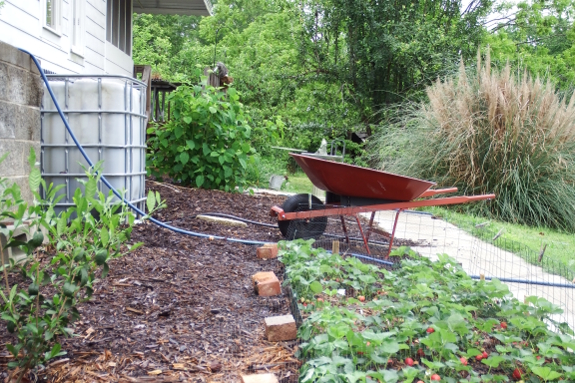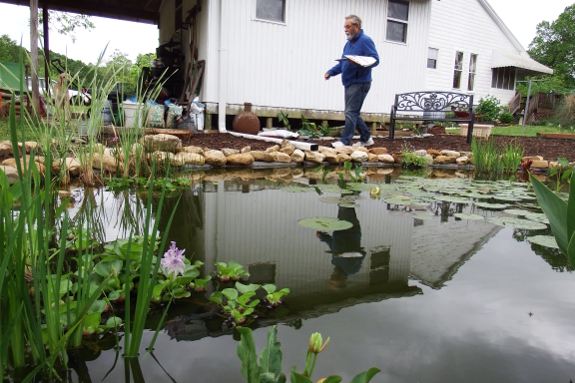
Rainwater catchment

The other tidbit I
wanted to share from my
South Carolina visit pertained to rainwater harvesting. Daddy's
climate is very drought-prone and his sandy soil means that whatever
rainfall hits the earth is gone in short order. Since he uses a well
for household water, there's a limit to how much he can divert for
irrigation purposes. Enter rainwater catchment, both in the form of the
rain
barrel shown above...

...and by channeling
gutter overflow directly into his water garden.
The oasis Daddy and
Barbara have created using minimal water is truly inspiring. I hope you
enjoy seeing rainwater catchment in action!
Want more in-depth information? Browse through our books.
Or explore more posts by date or by subject.
About us: Anna Hess and Mark Hamilton spent over a decade living self-sufficiently in the mountains of Virginia before moving north to start over from scratch in the foothills of Ohio. They've experimented with permaculture, no-till gardening, trailersteading, home-based microbusinesses and much more, writing about their adventures in both blogs and books.
Want to be notified when new comments are posted on this page? Click on the RSS button after you add a comment to subscribe to the comment feed, or simply check the box beside "email replies to me" while writing your comment.

A neighbor of mine has three of those huge 300gal rain "barrel". He was told recently that apparently the heavy-duty plastic that makes up the barrel will crack and break if left in the sun for a number of years. Have you heard anything about this? How long has your Pop had that "barrel" there and is it facing south?
Love the water garden! I'm jealous. I'm in the process of making something similar.
The ultraviolet component in sunlight has enough energy to break down the bonds in plastics. The more bonds are broken, the more brittle and weak the material becomes until it fails.
Thermoplastics (plastics that can melt) like the material IBC's are made of are generally more affected than thermosets (epoxy, polyester, "FRP"). Thermosplastics are the most used plastics by weight.
Plastic articles made for outdoor use generally are specially formulated. They often contain pigments to prevent solar radiation from completely penetrating the material and they can contain stabilizers. Note that the latter are a finite amount and are consumed in the process of protecting the plastic.
IBC's (especially the transparent ones) are not really made to be stored outside in full sunlight. On the other hand, they have relatively thick walls made by rotomoulding. So it will take time to degrade all that. But in the end, the material will fail.
Thank you Roland for the info. My neighbor decided to throw an old bedsheet he got from the thrift store over it to try to cut down on possible degradation.
I will pass on your info to him.